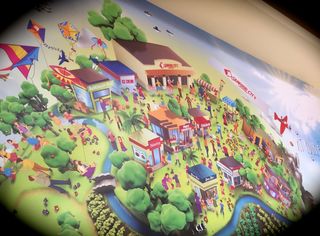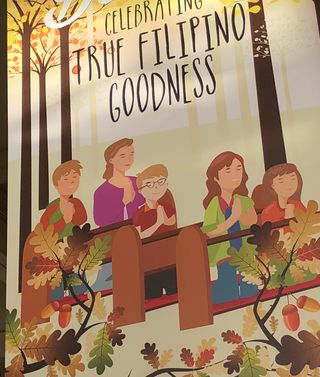Identity
What Color Is a Filipina?
Colorism within the Pilipino community.
Posted August 9, 2019 Reviewed by Ekua Hagan
While shopping in California at a local Filipino* shopping mall with my family, I looked up at a large cartoonish poster. Something seemed off to me. The faces looking back at us were all slightly rounded, peach complected, and brown-eyed.
I nudged my husband’s elbow and asked him, "What do you think is wrong with this picture?” The images of the families and individuals appeared busy and happy. Some were engaged in a picnic, while others were doing errands. But there was something wrong.
Before my husband could respond, I answered my own question. "All the complexions of these Filipina/os are light-skinned. Very light."

Yet, when we looked at the people who were shopping around us, it was a much different scene. The individuals in this communal space were just as busy but were mostly brown-skinned. Dark brown, medium brown, and light brown, but brown. In fact, my husband's skin color was many shades darker than the skin tone of the cartooned people who lingered above us.
We did not spend too long that day discussing the painting of the white-skinned Filipinxs that contrasted greatly with the Filipinx customers below. Instead, we proceeded to order our favorite Filipino dishes and delicacies. Several months later, the flavors of the food we enjoyed have long dissipated from our mouths. But the emptiness and the pit in my stomach remains.
I feel angry and unnerved by the messages being sent to the customers of this grocery store... the messages being sent to my family and the vulnerable minds of my children. Unfortunately, this image is not an exception. I have repeatedly seen posters and visuals like the one above at other grocery stores and restaurants.

Colorism and Colonial Mentality
My entry into the world of psychology gave me a vocabulary for what was happening. Colorism is the favoring of lighter skin color over darker skin, and colorism is a part of colonial mentality.
Colonial mentality is the idea that people with a history of colonization can take on the beliefs of their colonizers or oppressors that they are inferior. A psychological construct, the colonial mentality is an internalized oppression characterized by perceived cultural inferiority thought to be a consequence of centuries of colonization.
While Spanish and United States colonization in the Philippines ended over 70 years ago, the impact on the psyche of Pilipinos continues. The painting that stole my attention in the shopping center reflects the message that dark skin is undesirable.
Filipina/os tend to value "Western” physical features, such as fair skin and pointed noses, to the point that some buy skin whitening products and put clothespins on their noses to try and create a bridge. I’ve listened to my Filipinx friends, colleagues, and clients share the hurt and shame they have experienced when parents and family members have criticized their skin color, the shape of their nose, and eye shape. I firmly believe that many if not all of these family members did not intend to harm their loved ones, and rather felt they were speaking the truth and merely being honest.

Is This Healthy?
No. The impact of having one’s physical appearance criticized is often that people feel less-than and internalize the idea that they are inferior. This devaluing of your body and face can, unfortunately, be connected to shame, embarrassment, and resentment about one’s Filipino identity and overall self. In fact, psychological research finds that Filipino Americans who have higher levels of colonial mentality also have higher levels of depression, more dissatisfaction with their lives, and lower self-esteem.
While colonial mentality and colorism have negative impacts on identity and health, a positive ethnic identity serves as a protective factor. Having the opportunity to shop at Filipino grocery stores and bakeries is not available to Filipino Americans across the United States. For those who do have access to markets, like the grocery store I described above, Filipinx Americans have the opportunity to buy the foods they like, taste delicacies they cannot find elsewhere, speak and hear dialects of the Philippines, and connect with kababayan (“fellow Filipino/a countrymates”). This experience can be an opportunity to build pride and self-confidence in one’s identity and heritage.

I want my fellow Filipinx community to believe and feel that brown is beautiful too. Unfortunately, this is generally a message that Filipino/as are typically taught not to embrace. Case in point, there is literally an aisle in some Filipino grocery stories dedicated to skin whitening products.
Brown Is Beautiful
However, we can change the message we send to ourselves and Filipinx youth. I recently talked with my oldest son about skin color, and how Filipino/as come in different colors. I explained to him how my Lola (grandmother) is one of the lightest in our family, and then had us look together at our arms to see what color brown we are. My son engaged in a little bit of dialogue, and then went on to the next topic that was interesting to his 7-year old brain. I wasn’t sure any of this penetrated until a couple of weeks later I heard him tell my mom, “my skin is brown and beautiful." Listening to his words, I felt both proud and hopeful.
Suggestions for Spreading the Word That Brown Is Beautiful:
1. Read storybooks to the children in your life with characters with different skin tones, especially dark-complected ones. Use this as an opportunity to talk about the beauty in us all being different shades.
2. Open up a conversation about skin color when looking at family photos. Be clear and use language that is body positive and affirmative of all physical features. The first episode of Family Reunion on Netflix helped inspire me how to talk to my children about skin color. They, of course, used a bit more humor than I did, but it gave me a launching point, and I could talk about the characters with my son who loves that show.
3. Speak up, and let your grocery stores, restaurants, and other retailers know what you think about their advertising. As the customer, they care (or should care) about how their ads impact us. I did, and am eagerly awaiting their replies.

Of course, not all Filipinx Americans are the same nor do they all endorse colorism or colonial mentality. One of my aunts absolutely loves tanning, and thinks the darker the better! However, the images like the one I saw in the grocery store do not send these positive messages to its viewers. Therefore, I believe a crucial part of the healing and empowerment of Filipino community members is to be able to openly identify and challenge the negative, colorist messages out there.
#BrownisBeautiful #MagandangMorenx
*Throughout this article, variations of the term Filipino have been used, including Filipina, Filipinx, and Pilipino, in order to be inclusive of gender diversity and due to the complex, multiple ways people in our Filipina community identify.
Note. This blog post was adapted from an article written by Dr. del Prado that was originally published in the Division of Psychologists in Independent Practice of the American Psychological Association. It has been reproduced by permission of the Division of Psychologists in Independent Practice of the American Psychological Association.
References
David, E. J. R. (2008). A colonial mentality model of depression for Filipino Americans. Cultural Diversity and Ethnic Minority Psychology, 14(2), 118-127.
David, E. J. R., & Nadal, K. (2013). The colonial context of Filipino American
immigrants’ psychological experiences. Cultural Diversity and Ethnic Minority
Psychology 19(3), 298-309.
David, E. J. R., & Okazaki, S. (2006a). Colonial mentality: A review and
recommendation for Filipino American psychology. Cultural Diversity and Ethnic Minority Psychology 72(1), 1-16.
David, E. J. R., & Okazaki, S. (2006b). The Colonial Mentality Scale (CMS) for Filipino
Americans: Scale construction and psychological implications. Journal of Counseling Psychology, 53(2), 241-252.
Mossakowski, K. N. (2003). Coping with perceived discrimination: Does ethnic identity protect mental health? Journal of Health and Social Behavior, 44, 318-331.
Root, M. P. P. (1997). Contemporary mixed-heritage Filipino Americans: Fighting
colonized identities. In M. P. P. Root (Ed.), Filipino Americans: Transformation and identity (pp. 80-94). Thousand Oaks, CA: Sage.




